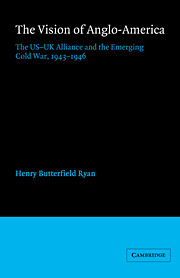Book contents
4 - Economic issues
from PART I - STRENGTHENING THE TIES: THE EFFORT AND THE PROBLEMS
Published online by Cambridge University Press: 07 December 2009
Summary
Economic issues were among the most vexing of those that arose between the United States and Great Britain during the period under consideration. While not precluding the extraordinarily close bonds between the two countries that Churchill desired and that his government worked for, questions like those which developed over Lend-Lease versus Britain's sterling balances, civil aviation, and oil resources proved very divisive.
In 1943, United States officials, moved mainly by the Treasury, began to question payments to Great Britain for raw materials, many of which went back to the UK as Lend-Lease manufactured items. In addition, the Americans maintained that the sole object of Lend-Lease was to provide Britain with war supplies when she lacked foreign exchange to buy them. By 1943, however, they calculated that Britain, partly as a result of Lend-Lease, had accumulated over one billion (1,000 million) dollars of exchange and consequently should pay for war materials until her exchange reserves dropped under the one billion level. The view was opposed in vain by Dean Acheson, then an Assistant Secretary of State, but supported by no less influential a group than Secretary of Treasury Henry Morgenthau, Jr; Secretary of State Cordell Hull; then Undersecretary of State Edward Stettinius, Jr, and Foreign Economic Administrator Leo Crowley.
British officials pointed out that a greater accumulation of foreign exchange would make an important difference in what they foresaw would be an economically difficult postwar period.
- Type
- Chapter
- Information
- The Vision of Anglo-AmericaThe US-UK Alliance and the Emerging Cold War, 1943–1946, pp. 54 - 70Publisher: Cambridge University PressPrint publication year: 1987

